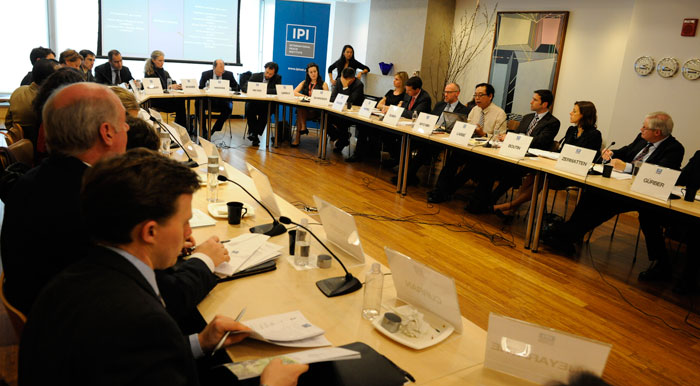
Various humanitarian actors have different attributes and comparative advantages that, for the sake of effective humanitarian action, are best used in a coordinated and strategic manner. This complementarity is all the more crucial with regard to engaging non-state armed groups to protect children in situations of armed conflict.
This was the starting point of the October 13th roundtable discussion on “Protection of Children in Armed Conflicts: Complementary Approaches to Engaging Non-State Armed Groups,” co-organized by the humanitarian organization Geneva Call and IPI, with the support of the Swiss Federal Department of Foreign Affairs.
This discussion, held under the Chatham House Rule of non-attribution, brought together some forty experts drawn from member states, the United Nations, and nongovernmental humanitarian organizations.
The views shared by the speakers reflected the perspectives and experience of various organizations and agencies involved in the protection of children in armed conflicts, including the United Nations Committee on the Rights of the Child, the United Nations Children’s Fund (UNICEF), the Office of the Special Representative of the Secretary-General on Children and Armed Conflict (SRSG-CAAC), Geneva Call, and the Burmese NGO Human Rights Education Institute.
The roundtable offered an opportunity to reflect on the formidable machinery that was built within the United Nations during the last decade, notably through the landmark Security Council Resolution 1612 of 2005, which created the Monitoring and Reporting Mechanism (MRM), and the central role played by the SRSG-CAAC office.
While acknowledging the achievements of the MRM process—largely based on a “name and shame” approach vis-à-vis armed groups responsible of violations of children’s rights—the various speakers looked at the ways their organizations can usefully complement this process to strengthen the protection of children in armed conflicts. They explored both the strengths and limitations inherent to their respective type of organization—international organization, international NGO, and local NGO—and discussed instances where different organizations’ comparative advantages to engaging non-state armed groups could be used in a complementary manner.
Despite the sensitivity of the issue, discussions reflected a broad agreement among participants on the necessity for humanitarian actors to engage nonstate armed groups to ensure a better protection of children in armed conflicts. Participants also agreed on obvious comparative advantages of some organizations over others, such as the ability of local NGOs, compared to their international counterparts, to work at grass-roots level and hence better understand the motivations of local non-state actors. In this respect, discussions showed a large consensus on the importance of using complementarity in a strategic and coordinated manner, in particular in context where some organizations might face difficulties, due to their very nature, that other humanitarian actors would not encounter.
Some disagreement among participants did appear in other instances where several humanitarian actors apply different approaches to engaging armed groups in a similar context. Some participants worried that different approaches might create duplication of efforts and send contradictory or confusing messages to nonstate armed groups, in particular concerning the child protection standards that have to be respected.
This roundtable demonstrated the value of a concerted use of complementarity, while showing the need for a continuing dialogue in order to make it effective.







